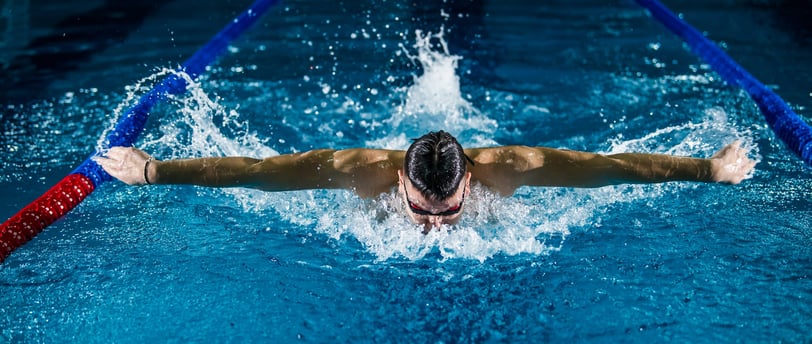Dive into Fitness: How Swimming Shapes Your Weight Loss Journey
SPORT


Introduction:
When it comes to weight loss, finding an exercise routine that you enjoy and can stick to is key. While running and cycling are popular choices, swimming often gets overlooked. However, swimming is a fantastic exercise that not only helps you shed those extra pounds but also offers a wide range of health benefits. In this article, we will explore how swimming can shape your weight loss journey and why it's a great option for anyone looking to get fit.
The Benefits of Swimming:
Swimming is a low-impact exercise that puts minimal stress on your joints, making it suitable for people of all ages and fitness levels. Here are some of the key benefits of swimming:
1. Full-Body Workout:
Unlike other forms of exercise that primarily focus on specific muscle groups, swimming engages your entire body. From your arms and legs to your core and back, every stroke works multiple muscle groups simultaneously. This means that swimming provides a comprehensive full-body workout, helping you tone and strengthen your muscles.
2. Cardiovascular Health:
Swimming is an excellent cardiovascular exercise that gets your heart pumping and improves your lung capacity. Regular swimming sessions can help lower your blood pressure, reduce the risk of heart disease, and improve overall cardiovascular health.
3. Weight Loss and Calorie Burning:
Swimming is a highly effective calorie-burning exercise. The exact number of calories burned depends on various factors such as your weight, intensity, and duration of the swim. On average, swimming can burn anywhere from 400 to 700 calories per hour. It's a great way to accelerate your weight loss journey and shed those stubborn pounds.
4. Low-Impact Exercise:
One of the biggest advantages of swimming is its low-impact nature. Unlike running or high-intensity workouts, swimming puts minimal stress on your joints and reduces the risk of injuries. This makes it an ideal exercise for people with joint pain, arthritis, or those recovering from injuries.
5. Improved Flexibility and Range of Motion:
Swimming involves a wide range of movements that help improve flexibility and increase your range of motion. The resistance of the water forces your muscles to stretch and work harder, leading to improved flexibility over time. Regular swimming can help prevent muscle stiffness and promote better overall mobility.
6. Stress Relief:
Swimming is not just a physical exercise; it's also a great way to relax and de-stress. The rhythmic movements and the sensation of being in water have a calming effect on the mind and body. Swimming can help reduce anxiety, improve mood, and promote mental well-being.
Swimming Techniques for Weight Loss:
While swimming in any form is beneficial for weight loss, incorporating specific techniques can maximize your results. Here are some swimming techniques to consider:
1. Interval Training:
Interval training involves alternating between high-intensity and low-intensity swimming. This technique helps boost your metabolism, increase calorie burn, and improve cardiovascular fitness. Try swimming at a fast pace for a few laps, followed by a slower, more relaxed swim to recover. Repeat this cycle throughout your swimming session.
2. Aerobic Swimming:
Aerobic swimming involves maintaining a steady pace throughout your swim. This technique helps improve endurance and stamina while burning a significant number of calories. Aim to swim continuously for at least 20-30 minutes, focusing on maintaining a consistent speed and rhythm.
3. Incorporate Different Strokes:
Swimming different strokes not only adds variety to your workout but also engages different muscle groups. Freestyle, butterfly, backstroke, and breaststroke all provide unique benefits and help target different areas of your body. Mixing up your strokes can prevent boredom and ensure a well-rounded workout.
4. Increase Distance and Intensity:
As you progress in your swimming journey, gradually increase the distance and intensity of your swims. Challenge yourself to swim longer distances or try to swim faster laps. Pushing your limits will help you build strength, endurance, and burn more calories.
Getting Started with Swimming:
If you're new to swimming or haven't swum in a while, here are some tips to help you get started:
1. Learn the Basics:
If you're a beginner, consider taking swimming lessons to learn the proper techniques and improve your form. Learning the basics will not only make your swimming sessions more effective but also help prevent injuries.
2. Start Slowly:
Don't push yourself too hard in the beginning. Start with shorter swimming sessions and gradually increase the duration and intensity as your fitness level improves. Listen to your body and take breaks when needed.
3. Find a Swimming Buddy:
Swimming with a friend or joining a swimming group can make the experience more enjoyable and motivating. Having a swimming buddy can also help you stay accountable and committed to your weight loss journey.
4. Set Realistic Goals:
Set realistic goals for yourself and track your progress. Whether it's swimming a certain distance or improving your speed, having goals can keep you motivated and focused on your weight loss journey.
5. Stay Consistent:
Consistency is key when it comes to swimming or any exercise routine. Aim to swim at least 2-3 times a week to reap the maximum benefits. Make swimming a part of your regular fitness routine to see long-term results.
Conclusion:
Swimming is a versatile and effective exercise that can shape your weight loss journey in numerous ways. From providing a full-body workout to improving cardiovascular health and promoting flexibility, swimming offers a wide range of benefits. Incorporate different swimming techniques, set realistic goals, and stay consistent to make the most out of your swimming sessions. So, dive into fitness and let swimming be your go-to exercise for weight loss and overall well-being!
